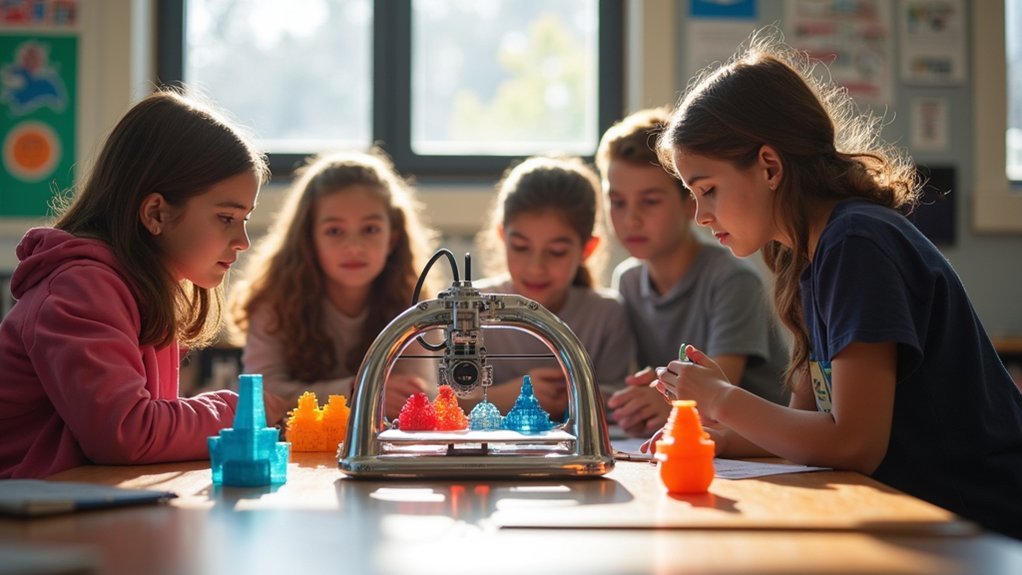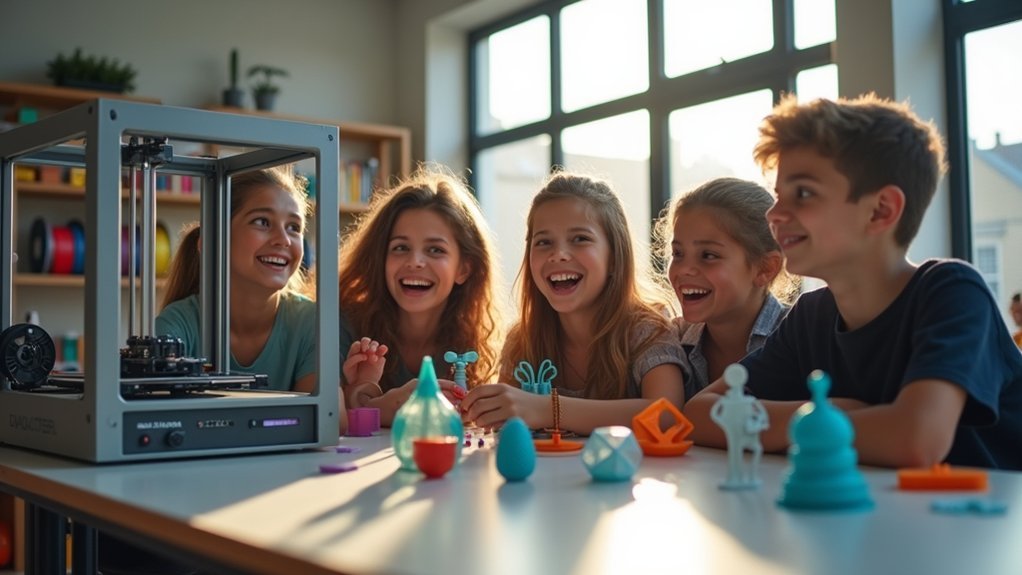You can secure funding for 3D printing technology through seven key grant opportunities: the Wolfson Foundation Education Grants offering £1.75 million annually, IET Funding providing up to £15,000 for innovative projects, The Royal Society Partnership Grants giving £3,000 for STEM initiatives, Institute of Physics grants up to £600, the Rolls-Royce Schools Prize awarding £5,000 to finalists, MakerBot’s 40+ curated funding programs, and Formlabs’ complete printer packages for accredited institutions. These extensive options will transform your educational capabilities.
The Wolfson Foundation Education Grants

When you’re seeking funding for 3D printing equipment in your secondary or special school, The Wolfson Foundation Education Grants offer a compelling opportunity. This foundation specifically targets secondary and special schools, providing capital project funding that enhances science and technology teaching capabilities.
You’ll find approximately £1.75 million available annually, distributed through biannual funding rounds in June and December. The grants support new builds, refurbishments, and essential equipment acquisition – making them ideal for printing technology initiatives.
Your application must demonstrate how the project improves educational outcomes in science and technology. You’ll need to align your proposal with the Foundation’s mission of advancing educational quality and innovation.
This means clearly articulating how 3D printing technology will enhance your students’ learning experiences and technical skills development.
Institution of Engineering and Technology (IET) Funding
The Institution of Engineering and Technology (IET) delivers substantial financial support for UK schools developing engineering education programs for students aged 5-19. You can secure up to £5,000 through standard applications, while exceptionally innovative projects may qualify for premium awards reaching £15,000. The IET typically distributes four of these higher-value grants annually.
Your 3D printing project will be evaluated based on innovation, educational relevance, and potential student impact. The funding specifically targets initiatives that boost youth engagement with engineering and technology concepts.
You’ll strengthen your application by partnering with industry professionals and STEM organizations, as the IET values collaborative approaches that create meaningful educational experiences. This support enables schools to implement cutting-edge printing technology while developing thorough engineering curricula.
The Royal Society Partnership Grants Scheme

Another powerful funding avenue emerges through The Royal Society Partnership Grants Scheme, which offers up to £3,000 specifically for schools implementing STEM projects targeting students aged 5-18.
This scheme creates valuable funding opportunities by encouraging collaboration between your school and STEM professionals to enhance science, technology, engineering, and mathematics education.
You can utilize these grants for purchasing 3D printing equipment that facilitates hands-on learning experiences and STEM investigations.
The program supports innovative projects designed to foster student engagement and interest in STEM subjects.
The program champions innovative educational initiatives that spark student curiosity and deepen engagement with science, technology, engineering, and mathematics learning.
When applying, you’ll need to emphasize collaboration and creativity in your project proposals.
The application process prioritizes partnerships that maximize educational impact, making it essential to demonstrate how your 3D printing initiative will meaningfully engage students while advancing their STEM learning outcomes.
Institute of Physics (IOP) Project Grants
You can secure up to £600 through the Institute of Physics Project Grants to fund 3D printing initiatives that enhance physics and engineering education in your school.
The application process requires you to demonstrate how your project will promote innovative teaching methods and increase student interest in physics for ages 5-19.
You’ll strengthen your application by including collaborations with STEM professionals who can enhance your project’s educational outcomes.
Grant Amount Limits
Up to £600 becomes available through Institute of Physics (IOP) Project Grants, specifically designed to support physics and engineering initiatives in UK schools. This education grant focuses on students aged 5-19, making it accessible across primary and secondary education levels.
You’ll find the funding supports innovative teaching methods and events that enhance physics education in your classroom. The £600 limit allows you to develop meaningful projects without requiring extensive budgets.
You can use these funds for 3D printing equipment, materials, or related educational activities that demonstrate physics principles. IOP assesses applications based on their potential to improve educational experiences and foster student engagement.
The grant’s scope encourages creative approaches to physics teaching, helping you develop unique projects that capture students’ interest in science and engineering fields.
Application Requirements Process
Success with IOP Project Grant applications hinges on submitting a thorough proposal that clearly articulates your project’s educational objectives and anticipated outcomes.
You’ll need to illustrate how your 3D printing initiative will enhance physics teaching and boost student engagement with the subject.
Your application must include:
- Detailed project objectives showing direct connections to physics education enhancement
- Clear budget breakdown explaining how you’ll use the funding effectively
- Evidence of how the project will increase student interest in physics concepts
- Plans for collaboration with STEM professionals to strengthen educational impact
The IOP particularly values applications that incorporate innovative teaching methods and practical physics applications.
Consider highlighting opportunities for Professional Development within your proposal, as this signifies long-term educational benefits beyond the initial project implementation.
Rolls-Royce Schools Prize for Science and Technology

You’ll find the Rolls-Royce Schools Prize for Science and Technology operates as a two-year rolling competition that can provide substantial funding for your school’s innovative STEM projects.
The prize structure offers up to sixty schools a £1,000 Special Merit Award, while six finalists receive an additional £5,000 plus valuable mentorship support.
Your school’s project must demonstrate innovation and practical application, with progress documentation through video submissions that help develop your students’ communication skills.
Competition Format and Awards
When you participate in the Rolls-Royce Schools Prize for Science and Technology, you’re entering a two-year rolling competition that’s designed to encourage hands-on STEM project development.
This prestigious program recognizes innovative student contributions through a structured award system that maximizes the benefits of 3D printing and other advanced technologies.
The competition features multiple award levels:
- Special Merit Awards: Up to sixty entries receive £1,000 each for innovative science project contributions
- Finalist Recognition: Six selected participants earn an additional £5,000 plus mentorship support
- Video Documentation: Required showcase materials demonstrating project progress and development
- Enhanced Support: Mentorship opportunities help finalists further develop their technological innovations
You’ll find this format encourages creativity while building practical STEM skills, ultimately inspiring future science and technology professionals through meaningful project-based learning experiences.
Project Requirements and Mentorship
Beyond understanding the award structure, you must meet specific project requirements to qualify for this competitive program. Your submission needs to demonstrate innovative science project proposals that emphasize hands-on STEM development.
The competition expects you to focus on practical applications of science and technology while showcasing creativity and problem-solving skills.
If you’re selected as one of the six finalists, you’ll receive exceptional mentorship opportunities that often provide invaluable guidance from Rolls-Royce professionals. These mentors work directly with you to enhance your project development experience, offering industry insights and technical expertise.
The program’s experiential learning approach helps you develop a deeper understanding of scientific principles through real-world application, making your project both educational and practically relevant for future STEM endeavors.
MakerBot Educational Funding Programs
MakerBot’s extensive educational funding initiatives provide educators with access to over 40 carefully curated grants, awards, and scholarships designed to bring 3D printing technology into K-12 classrooms.
These programs empower teachers with cutting-edge resources and strategic guidance that’ll transform your student learning experiences while enhancing your professional development in STEM fields.
Cutting-edge 3D printing resources and strategic guidance that transform student learning while advancing teacher professional development in STEM education.
The MakerBot Certified™ program lets you earn professional development credits while developing essential design skills for classroom 3D printer setup and management.
You’ll gain practical expertise that directly translates into innovative teaching methods.
Key benefits of MakerBot’s educational programs include:
- Access to thorough funding through their Grant Guide’s 40+ opportunities
- Strategic guidance for integrating 3D printing technology effectively
- Professional development credits through certification programs
- Cutting-edge resources specifically designed for K-12 education environments
Formlabs Innovation and Research Grant
Formlabs takes a different approach to educational support by offering their Innovation and Research Grant, which provides accredited institutions with a complete Form 2 3D printer package worth thousands of dollars.
You’ll receive everything needed to start advanced research: a Standard Resin Cartridge, Finish Kit, Resin Tank, and Build Platform, all backed by a one-year warranty.
Applications are accepted year-round, with one lab selected quarterly.
There’s no specific research theme required, giving you flexibility to propose projects that enhance critical thinking across any department.
Formlabs evaluates applications based on innovation and research potential, making this grant ideal for institutions seeking reliable, professional-grade 3D printing technology to elevate their educational programs and research capabilities.
Frequently Asked Questions
What Federal Grants Go to Schools?
You’ll find federal grants through Title I for low-income schools, IDEA for special education, Carl D. Perkins for career programs, NSF for STEM initiatives, and Department of Education funding for various educational improvements.
What Is the Most Profitable Thing to 3D Print?
You’ll find custom prosthetics most profitable, saving patients thousands while offering personalized fits. Unique jewelry, spare parts for niche machinery, business prototypes, and limited edition collectibles also yield high margins through exclusivity.
Can I Make Money From 3D Printing?
You can definitely make money from 3D printing by selling custom products, offering prototyping services, teaching workshops, or creating educational materials. Many entrepreneurs earn thousands monthly through online marketplaces and specialized services.
What Is the Technology Grant for Schools 2025?
You can access the Technology Grant for Schools 2025, which provides funding up to £1.75 million annually for acquiring advanced technologies like 3D printers to enhance STEM learning and student engagement.





Leave a Reply